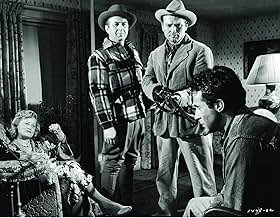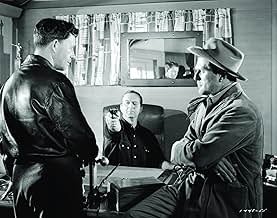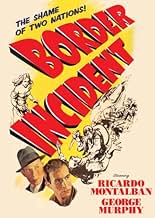CALIFICACIÓN DE IMDb
7.0/10
2.9 k
TU CALIFICACIÓN
Agrega una trama en tu idiomaMexican and American federal agents tackle a vicious gang exploiting illegal farm workers in southern California.Mexican and American federal agents tackle a vicious gang exploiting illegal farm workers in southern California.Mexican and American federal agents tackle a vicious gang exploiting illegal farm workers in southern California.
- Dirección
- Guionistas
- Elenco
José Torvay
- Pocoloco
- (as Jose Torvay)
Carlos Albert
- Policeman
- (sin créditos)
Harry Antrim
- John MacReynolds
- (sin créditos)
Lita Baron
- Rosita
- (sin créditos)
Robert Cabal
- Bracero
- (sin créditos)
Opiniones destacadas
An underrated gem from the cannon of Anthony Mann. Two agents - one American, one Mexican - cooperate on an investigation into illegal immigrant farm labour. The bad guys are the people smugglers, and boy are they bad - evil, ruthless and sadistic. Contains scenes of extreme violence which Hollywood tolerated in certain westerns and noirs of the late 40's post-war era, and this is kind of a western noir crime movie with lots of vegetables. Its a movie that could give you nightmares, especially if you approach it unaware due to its age, that its actually quite disturbingly brutal and relentless.
Easily ranks as Ricardo Montoblan's finest performance, and only makes one baffled as to how he became such a shameless ham later in life with the likes of Fantasy Island. George Murphy, who plays the American agent, had a fascinating career. Dropping out of Yale to become a coal stoker, he switched to a tap dancing hoofer in 30's pictures, then a solid supporting actor in war pictures. Following the lead of his pal Ronnie Reagan he entered Republican politics, rising to become a member of the US Senate for California.
John Alton lensed this picture, and his monochrome work is a remarkably beautiful achievement. Only a year after this movie Alton would photograph An American In Paris - easily one the best Technicolor movies ever shot.
Easily ranks as Ricardo Montoblan's finest performance, and only makes one baffled as to how he became such a shameless ham later in life with the likes of Fantasy Island. George Murphy, who plays the American agent, had a fascinating career. Dropping out of Yale to become a coal stoker, he switched to a tap dancing hoofer in 30's pictures, then a solid supporting actor in war pictures. Following the lead of his pal Ronnie Reagan he entered Republican politics, rising to become a member of the US Senate for California.
John Alton lensed this picture, and his monochrome work is a remarkably beautiful achievement. Only a year after this movie Alton would photograph An American In Paris - easily one the best Technicolor movies ever shot.
8tavm
With the death of Ricardo Montalban still fresh from a few weeks ago, I thought I'd check from my local library a DVD of one of his more dramatically compelling movies he made for his contracted studio, M-G-M. Directed by Anthony Mann just before his legendary streak of James Stewart westerns in the following decade, Border Incident has a sort of western feel as it tells the story of a couple of agents, one U.S. and one Mexican, trying to protect Mexican immigrants from being exploited and beaten to death in this country. Both Montalban and George Murphy-who's usually a song-and-dance man-are very compelling in their straight roles. As the villains, Howard Da Silva and Charles McGraw also bring their subtle creepiness to somewhat charismatic effect (well, Da Silva anyway). And James Mitchell brings his own charm as one of the migrant workers Montalban tries to help. There's also a naturalistic documentary feel in the beginning and end that make this somewhat realistic for the era which is also achieved by rare uses of the music score throughout. If you've only known Mr. Montalban as Mr. Roarke on "Fantasy Island" or as Khan on the "Star Trek" episode "Space Seed" not to mention Star Trek II: The Wrath of Khan, you'll probably be wonderfully surprised by his heroic role here. With that, I highly recommend Border Incident.
Border Incident is directed by Anthony Mann and adapted to screenplay by John C. Higgins from the George Zuckerman story. It stars Ricardo Montalban, George Murphy, Howard Da Silva, Charles McGraw, Arthur Hunnicutt and James Mitchell. Music is by Andre Previn and cinematography by John Alton.
The great Anthony Mann creates what is the perfect crossover movie that blends film noir style with western shadings. Mann would next go on to make the well regarded psychological westerns with James Stewart, Border Incident is the tasty meat in his noir/western sandwich.
In essence it's a remake of T-Men, only Mann and his team have shifted away from a hustle and bustle city setting to tell a story down on the sweaty American/Mexico border. We are probing into immigration issues, human smuggling and the abuse of such, Mann and his writers daring to portray the human suffering of farm workers from Mexico, lured in as slave labour, only to then be abused and used and much worse...
Having the legendary Alton on photography duties aids the downbeat thematics considerably, whilst also deftly averting attention from what is a pretty bog standard script, the low budgets never a problem where Mann and Alton were concerned. In fact, in noirville they worked it to their advantage with some striking lighting techniques and camera movements.
The pic is often vicious, sadistic even, landing violent scenes in the conscious that refuse to move until it's all over and the screen goes blank. Suspense is never far away in Border Incident, with a mostly on form cast (George Murphy is uneven as McGraw does nasty brilliantly) bringing the material to life as the dream team cloak it all in pictorial assertiveness. Not in the same league as Raw Deal, but highly recommended for reasons already stated. 8/10
The great Anthony Mann creates what is the perfect crossover movie that blends film noir style with western shadings. Mann would next go on to make the well regarded psychological westerns with James Stewart, Border Incident is the tasty meat in his noir/western sandwich.
In essence it's a remake of T-Men, only Mann and his team have shifted away from a hustle and bustle city setting to tell a story down on the sweaty American/Mexico border. We are probing into immigration issues, human smuggling and the abuse of such, Mann and his writers daring to portray the human suffering of farm workers from Mexico, lured in as slave labour, only to then be abused and used and much worse...
Having the legendary Alton on photography duties aids the downbeat thematics considerably, whilst also deftly averting attention from what is a pretty bog standard script, the low budgets never a problem where Mann and Alton were concerned. In fact, in noirville they worked it to their advantage with some striking lighting techniques and camera movements.
The pic is often vicious, sadistic even, landing violent scenes in the conscious that refuse to move until it's all over and the screen goes blank. Suspense is never far away in Border Incident, with a mostly on form cast (George Murphy is uneven as McGraw does nasty brilliantly) bringing the material to life as the dream team cloak it all in pictorial assertiveness. Not in the same league as Raw Deal, but highly recommended for reasons already stated. 8/10
Anthony Mann directed this still-timely drama that stars Ricardo Montalban as Mexican agent Pablo Rodriguez, who teams up with American agent Jack Bearnes(played by George Murphy) to tackle the problem of illegal Mexican Immigrant smuggling into California, which has seen many of them mysteriously murdered. Rancher Owen Parkson(played by Howard Da Silva) is chief suspect as the ringleader. Pablo goes undercover from the inside as an immigrant, while Jack investigates from the outside. The case will prove quite dangerous, more than either man realized... Fine drama with solid acting and direction, and an incisive script that wouldn't need much changing to work today, sadly.
Border Incident (1949)
This is an amazing movie. There are moments when it feels a little forced, or once or twice a little politicized, but the rest of the time this is as good as post-war movies get (and I'm a complete devotee of this period). John Alton's photography is worth seeing alone, even without the sound it's so good, not that you would want to avoid the fantastic score by Andre Previn. And the direction by Anthony Mann at the peak of his intensity is sharp and beautifully controlled.
The story is largely broken into two parts, though even these two get complicated, so you have to pay attention. Action moves from Mexican to the American side back and forth, following an American agent and a Mexican one (played by the handsome Ricardo Montalban), both undercover. They cross paths more than once, but largely their stories are independent. Eventually there is a huge and exciting confrontation in the Valley of Death with a thick and rather convincing quicksand pool at the bottom. It becomes something like a Western shootout at this point, something Mann became an expert at, but the movie as a whole has a unique feel to it, neither Western nor noir. Yes, it involves crime, guns, deception, and lots of night stuff (terrific is an understatement), but the underlying tone is to undo a crime syndicate on the border, and to root for the two heroes who are working for a cause (a very un-noir thing to do).
A terrific full review of the movie is at bighousefilm.com (click on reviews), in particular going into the director and cinematographer, and the overall mood of the film. Certainly this was my initial attraction, for both Mann in all his ominous but realistic violence and Alton with his deep focus shadow photography are favorites of mine. There isn't a dull moment in this film just in visual terms. If you watch with your eyes, and see great moving camera, vivid dark night stuff, and some sudden changes of focus (like when the two men are in the field at night toward the end and are suddenly up close in the camera, no cutting, just a fast running to the lens an following with the lens). It's really masterful.
But equally important for those who are curious about context and content beyond the art of it all is the Wikipedia entry on the Bracero program, a collaboration between the US and Mexican governments begun in the 1940s to control legal migrant workers. The need for lots of Mexican labor was pressing when millions of US men joined the army in 1942, and after the war there was pressure to keep the program going. In a way, this movie is pure propaganda to support its continuation, and it did get renewed time and again until 1964 (which is about when Cesar Chavez and the "La Raza" movement grew huge). Naturally, agribusiness didn't like it--their claim was they wanted to pay Americans full wages, not Mexicans, but in truth (apparently) they wanted to let the illegal market expand because illegals were so cheap and required no benefits. Whatever the case, "Border Incident" helps dramatize the need for some kind of program in post-war America just to counteract the bad guys running illegals over the border, to everyone's peril.
Speaking of which, the bad guy in charge is played to perfection by Howard Da Silva (who is not Hispanic, nor Portuguese, but Jewish American from Ohio). His whole cadre of greedy ranchers in the desert is convincing and a thrill, cinematically. There is only a glimpse of a female in the whole movie, and yet there is tenderness at times, especially among the braceros themselves. In a way there is something of the feel of "They Live by Night" here, with the layering of plots and types of people together in the dark desert, shot in the same year. But ultimately this is a far more masculine movie, filled with action and power plays and terrific energy.
This is an amazing movie. There are moments when it feels a little forced, or once or twice a little politicized, but the rest of the time this is as good as post-war movies get (and I'm a complete devotee of this period). John Alton's photography is worth seeing alone, even without the sound it's so good, not that you would want to avoid the fantastic score by Andre Previn. And the direction by Anthony Mann at the peak of his intensity is sharp and beautifully controlled.
The story is largely broken into two parts, though even these two get complicated, so you have to pay attention. Action moves from Mexican to the American side back and forth, following an American agent and a Mexican one (played by the handsome Ricardo Montalban), both undercover. They cross paths more than once, but largely their stories are independent. Eventually there is a huge and exciting confrontation in the Valley of Death with a thick and rather convincing quicksand pool at the bottom. It becomes something like a Western shootout at this point, something Mann became an expert at, but the movie as a whole has a unique feel to it, neither Western nor noir. Yes, it involves crime, guns, deception, and lots of night stuff (terrific is an understatement), but the underlying tone is to undo a crime syndicate on the border, and to root for the two heroes who are working for a cause (a very un-noir thing to do).
A terrific full review of the movie is at bighousefilm.com (click on reviews), in particular going into the director and cinematographer, and the overall mood of the film. Certainly this was my initial attraction, for both Mann in all his ominous but realistic violence and Alton with his deep focus shadow photography are favorites of mine. There isn't a dull moment in this film just in visual terms. If you watch with your eyes, and see great moving camera, vivid dark night stuff, and some sudden changes of focus (like when the two men are in the field at night toward the end and are suddenly up close in the camera, no cutting, just a fast running to the lens an following with the lens). It's really masterful.
But equally important for those who are curious about context and content beyond the art of it all is the Wikipedia entry on the Bracero program, a collaboration between the US and Mexican governments begun in the 1940s to control legal migrant workers. The need for lots of Mexican labor was pressing when millions of US men joined the army in 1942, and after the war there was pressure to keep the program going. In a way, this movie is pure propaganda to support its continuation, and it did get renewed time and again until 1964 (which is about when Cesar Chavez and the "La Raza" movement grew huge). Naturally, agribusiness didn't like it--their claim was they wanted to pay Americans full wages, not Mexicans, but in truth (apparently) they wanted to let the illegal market expand because illegals were so cheap and required no benefits. Whatever the case, "Border Incident" helps dramatize the need for some kind of program in post-war America just to counteract the bad guys running illegals over the border, to everyone's peril.
Speaking of which, the bad guy in charge is played to perfection by Howard Da Silva (who is not Hispanic, nor Portuguese, but Jewish American from Ohio). His whole cadre of greedy ranchers in the desert is convincing and a thrill, cinematically. There is only a glimpse of a female in the whole movie, and yet there is tenderness at times, especially among the braceros themselves. In a way there is something of the feel of "They Live by Night" here, with the layering of plots and types of people together in the dark desert, shot in the same year. But ultimately this is a far more masculine movie, filled with action and power plays and terrific energy.
¿Sabías que…?
- TriviaIn an interview with TCM, Ricardo Montalban, who was born in Mexico, pointed to this film as one of the few he made in Hollywood in which he actually played a Mexican.
- ErroresNear the end, Pablo Rodriguez (Ricardo Montalban) is almost fully submerged in quicksand. However, immediately upon being pulled out, he looks as if he's had a shower; the quicksand that had been on his face and hair is completely gone.
- ConexionesFeatured in Some of the Best: Twenty-Five Years of Motion Picture Leadership (1949)
Selecciones populares
Inicia sesión para calificar y agrega a la lista de videos para obtener recomendaciones personalizadas
- How long is Border Incident?Con tecnología de Alexa
Detalles
Taquilla
- Presupuesto
- USD 749,000 (estimado)
- Tiempo de ejecución1 hora 34 minutos
- Color
- Relación de aspecto
- 1.37 : 1
Contribuir a esta página
Sugiere una edición o agrega el contenido que falta

Principales brechas de datos
By what name was Mercado humano (1949) officially released in India in English?
Responda



































